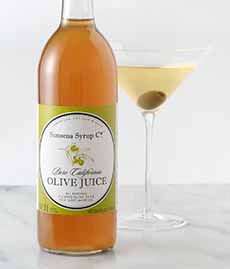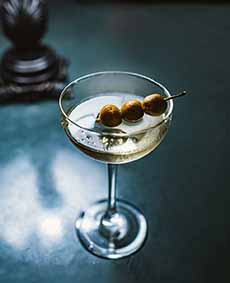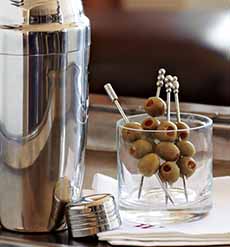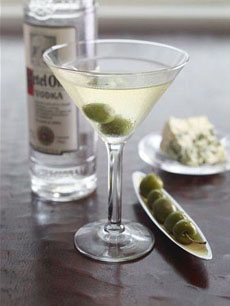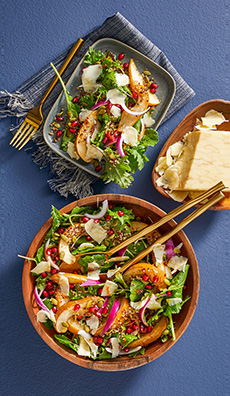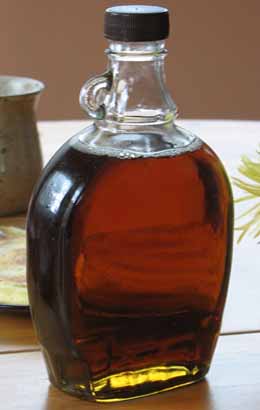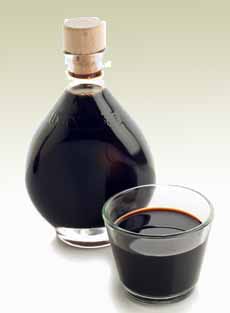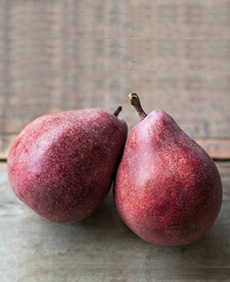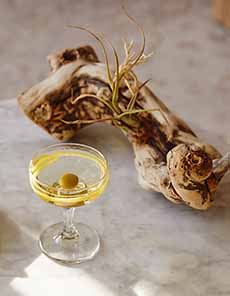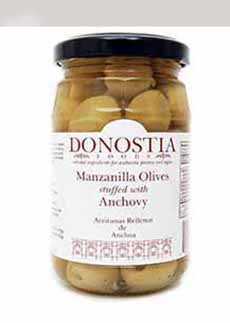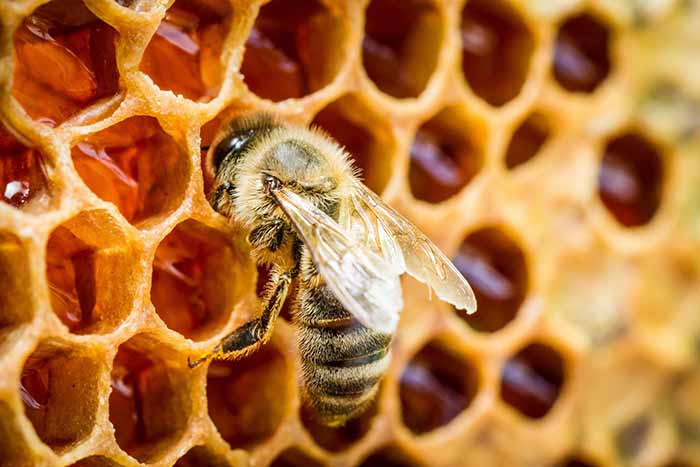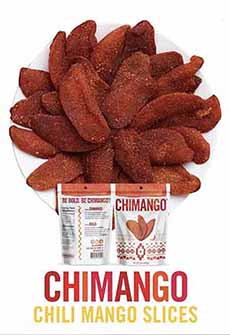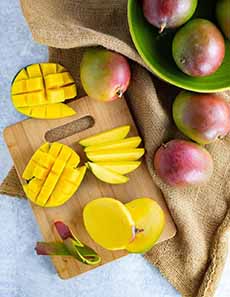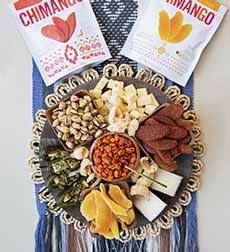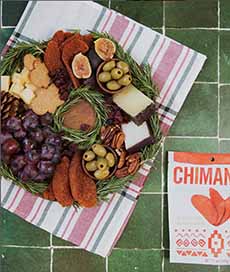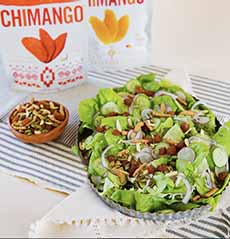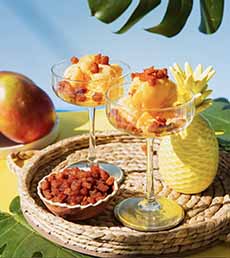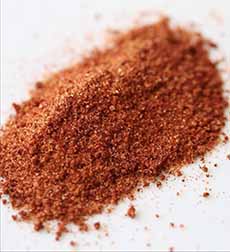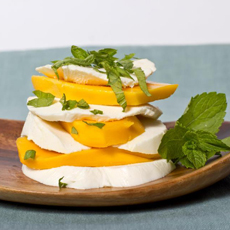|
It’s All About Bees, a line of creamed honey, liquid honey, and honey-based condiments (BBQ and other sauces, fruit butters, jams, jellies, mustards, salsas, syrups) by third-generation beekeeper Wendy Fletcher.
Her honey heritage dates to the 1930s when her grandfather kept bees in Homer, Nebraska.
In the 1970s, the Fletchers started beekeeping full-time. Four families bought an existing beekeeping operation in Iowa and ultimately settled in Omaha, Nebraska.
FABULOUS FLAVORED HONEYS FROMIT’S ALL ABOUT BEES!
Almost 25 years ago, the company began selling flavored honeys at farmers markets and craft shows, and then expanded to their own gift store and other retailers.
The line is hand-crafted and the natural flavorings are simply delish.
They are special, and there are varieties for every palate. Grandpa Rexroat would be proud.
For holiday season gifting, they come in sizes small enough for Thanksgiving party favors and large enough for a family.
Artisan Honeys
The company specializes in small-batch, artisan, all-natural, and sustainably-produced.
The recipes are lower in sugar—containing, the company says, 30% less sugar than other flavored honeys. There are:
Spreadable creamed honey in 23 flavors (photo #1).
Liquid honey in 10 flavors, packaged in squeezable plastic honey bears (photo #2).
There are also raw, unflavored varietal honeys (Buckwheat, Orange Blossom) in jars, honey bears, and honey sticks; plus honey-based personal care products.
For holiday gifts, we looked at the seasonal flavors. Each flavor is so pure and distinctive, we’re glad we tried a selection.
[Note to Santa: We’d be delighted to try them all.]
Holiday Flavors
Though they’re available year-round, these are spot-on flavors for the holidays. The flavors are fresh and lively. Cinnamon, for example, tastes like a stick of cinnamon was freshly grated into the jar.
For holiday gifts, we selected jars of:
Apple Cinnamon Honey
Cinnamon Honey
Chai Spice Honey
Christmas Berry Honey
Ginger Honey
Gingerbread* Honey
Pumpkin Spice Honey
Most flavors are available in three sizes:
2-ounce minis (party favors, stocking stuffers)
10-ounce half-pints
22-ounce pints
At the rate we’ve been spooning up the wonderful chocolate honey and peanut butter honey flavors (a.k.a. “candy in a jar”), we’ll need to re-order the largest size.
More Flavors
Beyond our holiday flavor picks, there’s plenty on offer:
Family Favorite Flavors: Chocolate, Peanut Butter, Salted Caramel, and Vanilla Honeys.
Fruit Flavors: Blackberry, Cherry, Elderberry, Lemon, Lime, Orange, and Raspberry Honeys.
Herb & Spice Flavors: Lavender, Lavender Beenilla, and Turmeric Honeys.
Hot Flavors: Cayenne and Extreme Ginger in creamed honey jars; honey bears with squeezable liquid heat in Hot Honey and Really Hot Honey.
GET YOUR HONEY FROM IT’S ALL ABOUT BEES!
You can find the products:
At Whole Foods Markets, other fine retailers, and Amazon (all have limited flavors and sizes).
Everything is available on ItsAllAboutBees.com.
If you ordered one of every flavor, what would we think?
We’d think you were in for a really sweet time.
Why not have a holiday tea party to kick it off? Use the honeys to:
Sweeten tea.
Spread then on crackers and canapés.
Use as condiments with cheeses and charcuterie.
Mix them into dips for fruit.
Spread them on shortbread and graham crackers or on loaf cakes (angel food, carrot, and pound cakes, zucchini bread).
ANNUAL HONEY HOLIDAYS
January 11: National Hot Toddy Day
January 18: Winnie the Pooh Day
May, First Full Week: National Wildflower Day
May 20: World Bee Day
August, First Saturday: National Mead Day
August 2: Don’t Step On A Bee Day
August, Third Saturday: World Honey Bee Day
September: National Honey Month
September: Rosh Hashanah*
November 17: National Baklava Day
MORE HONEY HAPPINESS
> The different forms of honey.
> 30 tasty uses for honey.
> Ways to use creamed honey.
> The history of honey.
> Honey facts and trivia.
> Honey statistics.
> Honey varietals (monofloral honeys).
> Pairing varietal honeys with foods and beverages.
> Photo glossary: The different types of honey, sugar, and syrup.
> Storing and using honey.
> How to get every last drop of honey from the jar.
HOW HONEY IS MADE
Worker bees collect nectar from the base of the flower with their tongues, and use “pollen baskets” (corbiculae) on their hind legs to collect pollen from the anthers (the top of the stamens)
They fly back to the hive to pass the nectar and pollen to other worker bees (all workers are female), who store it in the honeycomb cells (photo #10).
Those bees use enzymes and proteins in their stomachs to break down the nectar’s complex sugar, sucrose sugar, into simpler sugars into fructose and glucose and by the removal of excess moisture into simpler forms that are less likely to crystallize.
They fan the substance with their wings to remove excess moisture. This turns the substance into the thick, viscous liquid we call honey.
More nectar and pollen are brought back to the honeycomb cells. Worker bees then seal the cells with a thin layer of wax secreted from their abdomens.
Beekeepers use centrifugal force from a spinning device called a honey extractor. This removes the honey from the comb while leaving the wax comb intact, allowing the bees to reuse it.
Trivia: Only female bees have stingers. Worker bees, all females, do all the work in the hive. Males (called drones) do nothing; their only job is to mate with the queen to produce more bees. When mating season is over, the worker bees force the drones, out of the hive where they die from starvation or hypothermia.
Etymology: The English word honey began in the ancient Germanic tongue as huna(n)go, which became honung in Old Norse, and then hunig in Old English. In Medieval English that became hunig, which turned into the modern word honey (and its variation, “hunny” if you’re part of Winnie The Pooh’s cohort).
|
|

[1] Honey in fall and holiday flavors: Apple Cinnamon, Chai Spice, and Cinnamon (photos #1, #2, #3 © It’s All About Bees!).
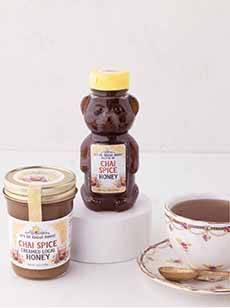
[2] Flavored honeys in wonderful flavors come in jars of spreadable creamed honey and honey bear squeeze bottles of liquid honey.
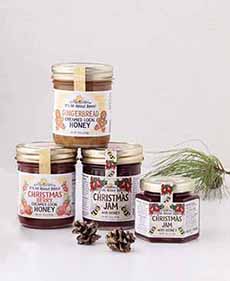
[3] Christmas, Gingerbread, and other holiday flavors are great for gifts.
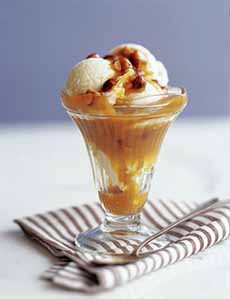
[4] Use flavored honey to top ice cream (photos #4, #6, #7, #8, #10 © National Honey Board).

[5] Serve flavored honey with apples, pears, or oranges—a wonderful add-on when the fruit isn’t as sweet as you’d like (photos #5, #9 © Good Eggs).
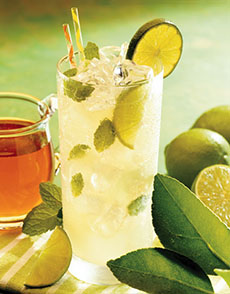
[6] A Mojito made with honey instead of refined cane sugar.
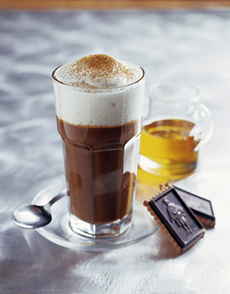
[7] How about sweetening your latte with cinnamon honey?
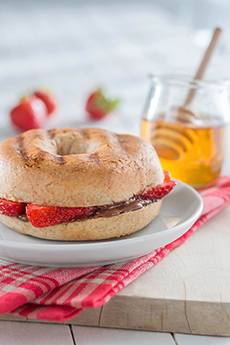
[8] What’s new on bagels? How about fresh strawberries and peanut butter honey?
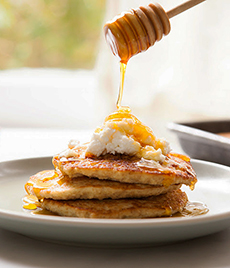
[9] Beyond maple syrup: pancakes with the flavored honey of your dreams (cayenne? lavender?).
|
